Physical Address
304 North Cardinal St.
Dorchester Center, MA 02124
In contrast to the common pleural metastases from pulmonary and extrapulmonary malignancies, primary tumors of the pleura constitute a relatively rare group of benign and malignant neoplasms, with different pathways of differentiation and histogenesis reflecting the complexity of the serosal membrane lining the thoracic cavity. The pleura contains not only a mesothelial lining but also a subjacent matrix of elastic fibroconnective tissue containing blood vessels, lymphatics, and scattered submesothelial mesenchymal cells. Tumors arising from the pleura manifest differentiation reflecting each of the constituent cell types. Despite different pathways of histogenesis, primary pleural neoplasms often closely resemble one another, as well as metastatic tumors, sharing common gross distributions and histologic patterns. Accordingly, the pathologist’s task to render a proper diagnosis for these tumors can be laborious and may require the use of several ancillary studies, as well as familiarity with pertinent clinical and radiographic features. The malignant tumors of the pleura share the common features of diagnosis at a typically late stage, difficult clinical management, and aggressive behavior, whereas the resectability of the benign lesions frequently predicts biologic behavior and prognosis.
Group of histologically diverse, clinically aggressive malignant epithelial neoplasms arising primarily in the serosal membranes of the pleural cavity and peritoneum and demonstrating mesothelial differentiation
Rare tumors, with an estimated incidence of 15 to 20 cases per million
Higher frequency in men
Typically associated with occupational or paraoccupational exposure to amphibole asbestos
Long latency period after exposure and peak incidence in late adulthood
Typical presentation at late stage with bulky pleural/chest wall tumors and accompanying large effusions, dyspnea, and chest pain
Usually large pleural-based mass(es) or circumferential encasement of lung by the tumor, which appears as thickened pleura
Tumor growth into diaphragm, pericardium, and chest wall is often observed
Pleural effusion
Highly aggressive tumors with dismal prognosis related to typical presentation at late stage
Death often within 1 year after diagnosis
Survival benefit for radical surgery and adjuvant chemoradiotherapy in select group of patients, but for most patients therapies are palliative
Early lesions consist of multiple pleural nodules
Late-stage tumors encase the lung in a confluent rind of tumor with growth down fissures and interlobular septa and into diaphragm, pericardium, and chest wall
Hilar and mediastinal lymph node metastases frequently develop with advancing disease
Epithelioid, sarcomatoid (including desmoplastic), and biphasic subtypes
Spectrum of histologic appearances within each of the variants described in the text
Mesotheliomas can produce acid mucopolysaccharides/hyaluronic acid and are alcian blue/colloidal iron positive, sensitive to hyaluronidase pretreatment
Mesotheliomas characteristically do not produce mucins (although rare cases may show focal staining)
PAS reaction due to cytoplasmic glycogen is reversed with diastase pretreatment
Epithelioid mesotheliomas are generally positive for cytokeratins, including cytokeratin 5/6, calretinin, Wilms tumor antigen (WT1), and D2-40 and usually stain negatively for CEA, CD15, Ber EP4, B72.3, MOC31, and TTF-1
Cytokeratin and vimentin immunoreactivity is typical of sarcomatoid and desmoplastic variants, whereas other “mesothelial-specific” antibodies are less likely to be positive than in epithelial mesotheliomas
Cytokeratin immunostains are useful in desmoplastic mesotheliomas for demonstrating subpleural soft tissue invasion
BAP1 immunostain is negative in benign mesothelial proliferations and generally positive in malignant mesotheliomas
Classic features of epithelioid mesothelioma tumor cells include long, slender surface microvilli with aspect ratios in excess of 10:1, abundant intermediate filaments, and tonofibrillar bundles
9p21 homozygous deletion by FISH differentiates malignant mesothelioma from benign reactive mesothelial proliferations
Epithelioid mesothelioma
Reactive conditions with mesothelial hyperplasia
Adenocarcinoma metastatic to pleura
Epithelioid angiosarcoma
Epithelioid metastases of nonepithelial malignancies (eg, malignant melanoma)
Sarcomatoid mesothelioma
Solitary fibrous tumor
Primary and metastatic sarcomas of the pleura
Sarcomatoid carcinomas of the lung and elsewhere (metastatic)
Sarcomatoid metastases of nonepithelial malignancies (eg, malignant melanoma)
Desmoplastic mesothelioma
Solitary fibrous tumor
Desmoid tumor
Fibrosing pleuritis (fibrous pleurisy)
Malignant mesotheliomas constitute the group of aggressive malignant epithelial neoplasms arising from the serosal membranes lining the pleural and peritoneal cavities, as well as the pericardium. These cavities are lined by a single layer of flattened to cuboidal cells of mesodermal origin constituting the mesothelium, but it remains uncertain whether mesotheliomas result from transformation of the differentiated mesothelial cell, progenitor submesothelial mesenchymal cells, or both. Mesothelioma develops most frequently in the pleura, but its counterparts in the pericardium, peritoneum, and tunica vaginalis of the testis are also well recognized.
A historically rare neoplasm, mesothelioma in North America has an incidence of 15 to 20 cases per million persons per year for men and a much lower incidence in women. It remains a signal malignancy, an epidemiologic marker for exposure to asbestos, with which it is most highly associated. The peak incidence for mesothelioma in North America is likely on the wane, but the tumor’s incidence in Europe, Australia, and Japan, as well as developing countries, may not peak for several more decades, in the latter instances due to a more contemporaneous usage of asbestos in those societies relative to the Western world. Malignant pleural mesothelioma has an overwhelming male predominance, reflecting the predominance of men in occupations most commonly associated with asbestos exposure. Exposure to commercial amphibole asbestos remains the major cause of pleural mesothelioma; yet it remains uncertain why, among the millions of individuals so exposed, so few develop mesothelioma. At least in men, epidemiologic studies have shown that historically 80% to 90% of pleural mesotheliomas are asbestos related. There remains a subset of cases that cannot be attributed to asbestos exposure (based on asbestos fiber analysis in lung tissue and exposure history), indicating that other factors are likely involved in the pathogenesis. These factors have proven to be elusive, and the search for cocarcinogens and predisposing factors remains ongoing. Typical of asbestos-associated diseases in general, a prolonged latent interval, that period of time between exposure and the development of clinical disease, is characteristic and, in the case of mesothelioma, is usually measured in decades. Due to its potential for clinically silent growth, the presentation of mesothelioma is all too often at a late stage and is usually characterized by dyspnea and pleural effusion and may be accompanied by chest pain stemming from chest wall invasion. Distant metastases are often discovered at autopsy but are rarely of clinical significance premortem and may remain undetected during life. Invasive procedures such as thoracoscopy may lead to development of subcutaneous tumor nodules.
Plain chest radiographs typically show pleural effusions and often pleural-based tumor masses. Radiographically demonstrable pleural plaques indicative of asbestos exposure are observed in 20% of cases. Locally advanced tumor is often evident, with circumferential encasement of the lung by a lobulated rind of tumor, with extension into fissures and interlobular septa. In rare cases, a single dominant tumor mass may be demonstrable. Computed tomography and magnetic resonance imaging may aid in demonstrating chest wall or diaphragmatic invasion and are useful in preoperative assessment of resectability.
The typical gross features in early disease consist of small nodules in the parietal pleura, although the visceral pleura may give rise to mesothelioma as well. Subsequent growth leads to coalescence of these nodules, with extensive involvement of the pleural surfaces ( Fig. 32.1 ). The circumferential rind of tumor at late stage is typically lobulated, firm, and white ( Fig. 32.2 ). Tumor growth follows the distribution of the pleural surface with invasion into mediastinum, chest wall, and diaphragm. The tumor tracks along the pleural reflections into the lung fissures, and fingerlike extensions into interlobular septa are common. Metastases to mediastinal and hilar lymph nodes, as well as the parenchyma of the lung, are usually evident in late-stage disease. Rare instances of localized invasive mesothelioma without diffuse pleural spread have been reported.
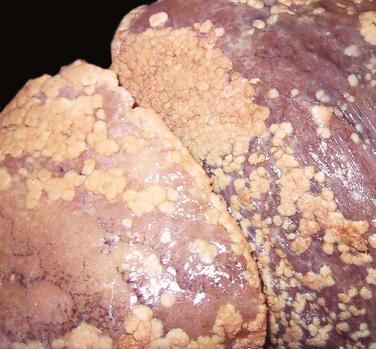

Malignant mesothelioma is characterized by a broad range of microscopic appearances, often within an individual tumor. The World Health Organization recognizes epithelioid, sarcomatoid (including desmoplastic), and biphasic diffuse malignant mesotheliomas. The most common variant is epithelioid, featuring tubulopapillary, pseudoacinar, microglandular, trabecular, or solid growth patterns, or combinations thereof ( Fig. 32.3 ). The tumor cells are typically cuboidal, with moderate amounts of cytoplasm and paracentric nuclei. Cytologic atypia is typically modest in comparison to adenocarcinoma, the principal member of its differential diagnosis, although pleomorphic mesothelioma with characteristic high-grade cytologic features is recognized, as is the unusual deciduoid subtype. The deciduoid variant, initially reported as a peritoneal tumor in young women, also occurs within the pleura and has cytologic features reminiscent of the decidual reaction with round or polygonal cells and abundant cytoplasm ( Fig. 32.4 ). Other known growth patterns include micropapillary, adenomatoid (microcystic), clear cell, transitional, and small cell. In the micropapillary pattern, papillary structures are present that lack the typical fibrovascular cores. Adenomatoid pattern consists of microcystic structures with a signet-ring appearance. As the descriptor suggests, the clear cell pattern consists of large cells with abundant clear cytoplasm, which must be distinguished from renal cell carcinoma. Transitional pattern refers to a sheetlike growth pattern composed of cohesive cells with an elongated morphology. The small cell pattern refers to a pattern mimicking small cell carcinoma. Papillary areas in diffuse malignant mesothelioma must be distinguished from well-differentiated papillary mesothelioma, which can be problematic in a small biopsy (see “Differential Diagnosis” later). The sarcomatoid variant is the least common and features architectural complexity with storiform and fascicular growth patterns with spindled cellularity of high nuclear grade ( Fig. 32.5 ). The tumor may incorporate giant cells, mimicking malignant fibrous histiocytoma, or have heterologous elements composed of osteosarcomatous or chondrosarcomatous foci ( Fig. 32.6 ). The desmoplastic variant of sarcomatoid mesothelioma is particularly deceptive, composed largely of hyalinized collagen, challenging the pathologist to demonstrate frankly sarcomatoid foci or invasion into subpleural tissues that help permit its distinction from the benign fibrosing pleural reactions it may resemble ( Fig. 32.7 ). The biphasic variant of malignant mesothelioma exhibits one or more of the many epithelioid patterns, as well as areas of sarcomatoid tumor. Rare, localized cases of malignant mesothelioma have been described and show histology identical to any of the subtypes of diffuse malignant mesothelioma. They appear as a solitary and circumscribed mass that usually grows into the chest wall or adjacent lung.
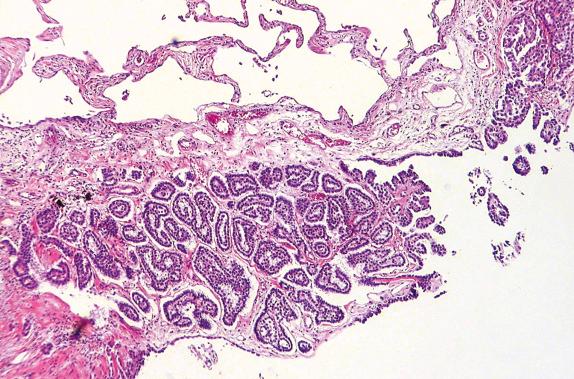
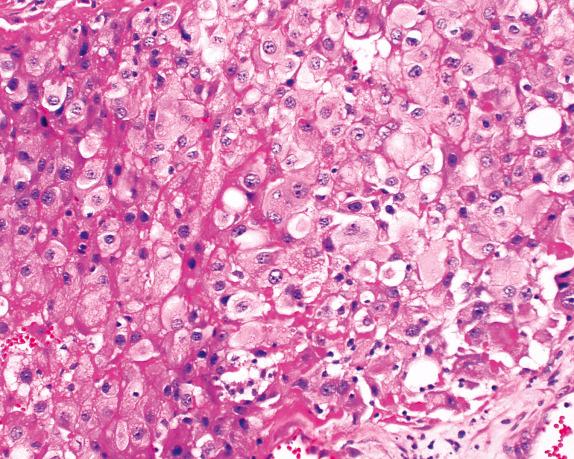
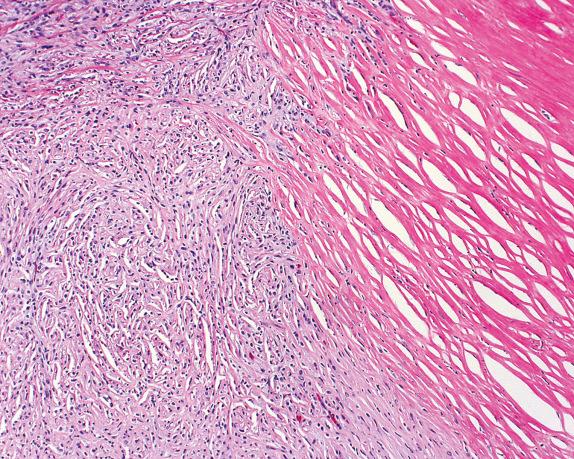
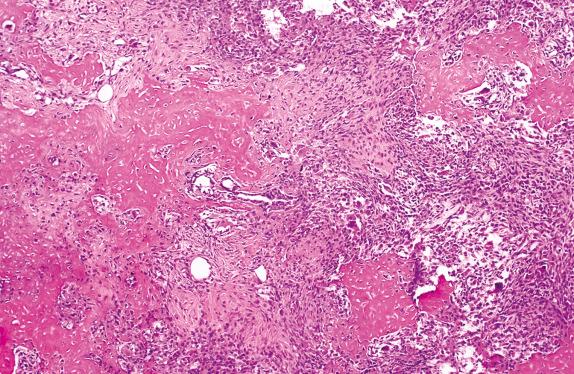
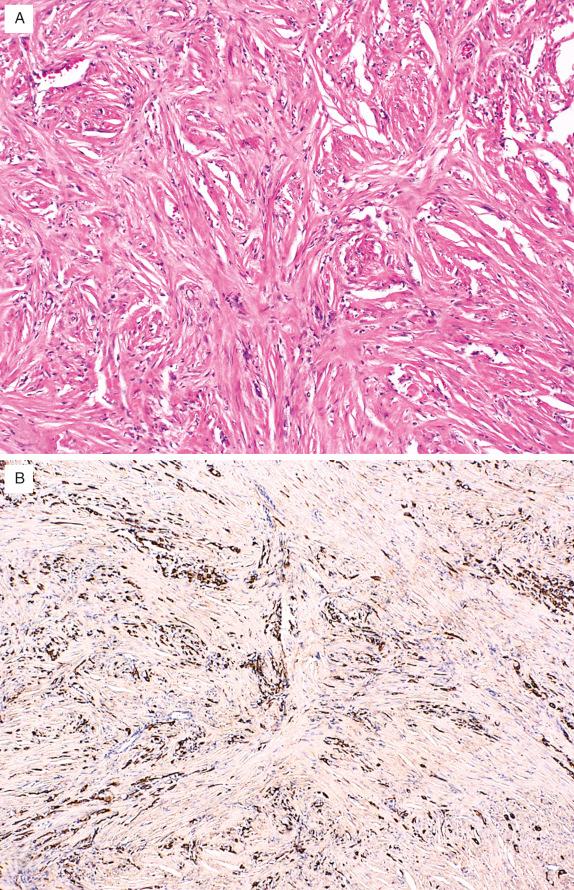
Some 90% of malignant mesotheliomas are associated with pleural effusions. The presence of diagnostically useful cells in effusion cytology may be affected by histologic subtype, with sarcomatoid and desmoplastic variants resulting in more paucicellular effusions than epithelial neoplasms ( Fig. 32.8 ). Given the difficult distinction between the reactive and malignant mesothelial phenotype, even aided by immunohistochemistry, the diagnosis of mesothelioma based solely on cytologic grounds is hazardous, and effusion cytology is best used as a screening test and precursor to more definitive studies such as thoracoscopic or percutaneous core needle biopsy. Cytologic examination of pleural fluid is also valuable for diagnosis of metastatic neoplasms, particularly adenocarcinomas, which may clinically and radiographically resemble mesothelioma.
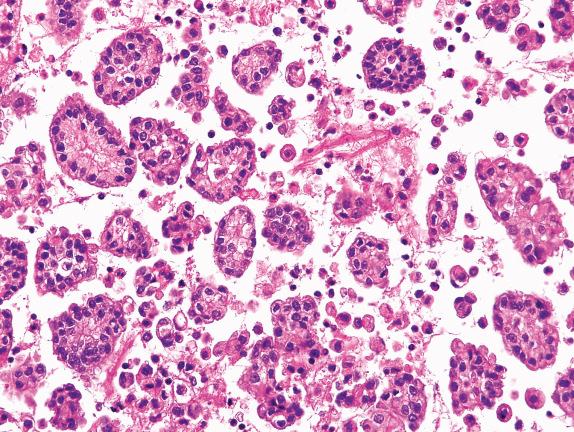
Histochemical staining for neutral mucins and hyaluronic acid may occasionally be useful in distinguishing adenocarcinoma metastatic to the pleura from epithelial mesothelioma, but it has largely been supplanted by immunohistochemistry. Mucin production is typical of adenocarcinoma and can be detected with a periodic acid–Schiff (PAS) stain, with mucin specificity enhanced by diastase predigestion. Mucicarmine staining also frequently highlights cellular mucin in adenocarcinomas, but staining has also been described in a subset of mesotheliomas. Hyaluronic acid production is more typical of mesothelioma, and this can be highlighted with alcian blue or colloidal iron stains, reversible with hyaluronidase pretreatment.
Immunohistochemistry is chiefly used for distinguishing epithelial mesothelioma from adenocarcinoma. A panel approach is usually taken, with the panel composed of antibodies with high sensitivity and specificity for mesothelioma and adenocarcinoma. Epithelioid mesothelioma generally demonstrates positive immunoreactivity for calretinin, cytokeratin 5/6, Wilms tumor 1 (WT-1), and D2-40 ( Fig. 32.9 ) and stains negatively for carcinoembryonic antigen (CEA), thyroid transcription factor-1 (TTF-1), Ber-Ep4, B72.3, and CD15. A converse immunophenotype is typically observed for adenocarcinoma involving the pleura. Numerous other antibodies have also been evaluated, with variable reproducibility. Immunoreactivity with pan-keratin antibodies does not distinguish between mesothelioma and adenocarcinoma but is valuable for supporting diagnoses of sarcomatoid and desmoplastic mesotheliomas. Unfortunately, reactive stromal proliferations can also show immunostaining for pan-keratin, so a positive result should not be construed as providing definitive evidence of malignancy, and histologic criteria for malignancy must still be fulfilled. Furthermore, cytokeratin immunoreactivity is observed in synovial sarcoma, as well as some angiosarcomas, and constitutes a potential source of confusion in the evaluation of sarcomatoid or biphasic tumors. Recently, the BAP1 immunostain has been shown to be a potentially useful marker to differentiate malignant mesothelioma from benign reactive mesothelial proliferations. BAP1 is expressed in benign proliferations, whereas mesotheliomas (epithelioid/biphasic type more often than sarcomatoid/desmoplastic) are BAP1 negative. As is generally true, immunohistochemical staining results must be interpreted in the context of the histopathology, and use of a panel approach to evaluation of pleural neoplasms can often provide a greater degree of security than reliance upon one or two stains.
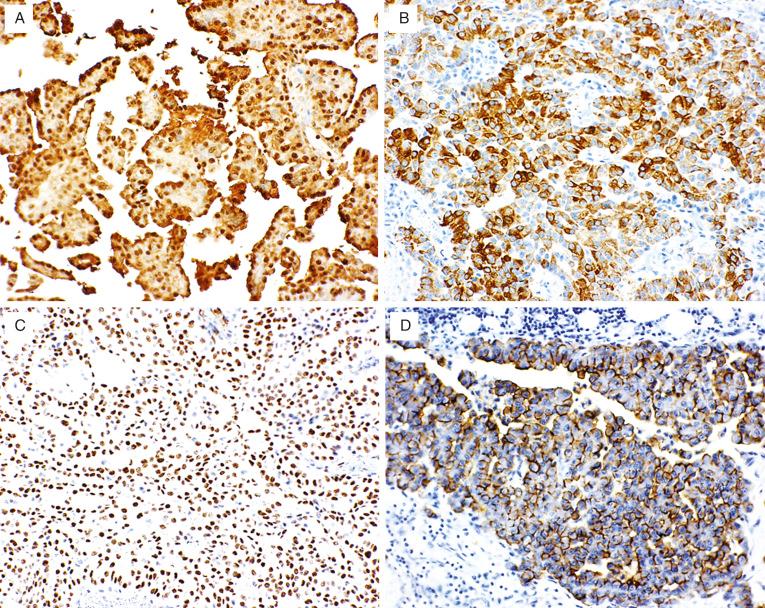
Equivocal histochemical or immunohistochemical findings in cases of suspected epithelial mesothelioma may be clarified using transmission electron microscopy. Although no single ultrastructural feature is unique to mesothelioma, the combination of long, slender surface microvilli, abundant intermediate filaments, and tonofibrillar bundles is characteristic.
The BAP1 gene (BRCA1-associated protein 1), located at 3p21.1, has been identified as a tumor suppressor gene. The gene is expressed normally in benign mesothelial lesions, whereas somatic gene-inactivating deletions or point mutations are detected in malignant mesotheliomas, as well as other malignancies within a BAP1 cancer syndrome. Many malignant mesotheliomas have been found to demonstrate a homozygous deletion of 9p21, resulting in the loss of CDKN2A (cyclin-dependent kinase inhibitor 2A). This gene codes for several proteins, including p16, a well-known tumor suppressor. Fluorescence in situ hybridization (FISH) for homozygous deletion of p16 can aid in differentiating malignant mesothelioma from benign reactive mesothelial proliferations.
Malignant mesothelioma must be distinguished from reactive conditions leading to mesothelial hyperplasia and benign fibrosing pleural conditions. The demonstration of stromal, subpleural, or chest wall invasion is invaluable for differentiating between mesothelioma and reactive processes. Another helpful finding is necrosis, which favors malignancy. Also, with spindle cell proliferations, an evolution from hypocellular fibrinous exudate to granulation tissue to fibrosis, as one moves from the luminal surface deeper, is more in keeping with an organizing pleural effusion (also see Chapter 34 ). Other malignant tumors that may be considered in the differential diagnosis include a broad spectrum of carcinomas and sarcomas metastatic to the pleura, as well as the uncommon sarcomas arising primarily in the pleura (also see Chapter 33 ). Immunohistochemistry facilitates differentiation between these entities and malignant mesothelioma (see earlier). Well-differentiated papillary mesothelioma (WDPM), originally described as an indolent neoplasm involving the peritoneum of young women, demonstrates fibrovascular cores lined by a single layer of cuboidal cells with minimal nuclear atypia and only focal stromal invasion ( Figs. 32.10 and 32.11 ). WDPM typically appears as small translucent nodules, as opposed to the usual rindlike or multinodular appearance of malignant mesothelioma, and malignant mesothelioma demonstrates more invasion and areas of solid tumor.
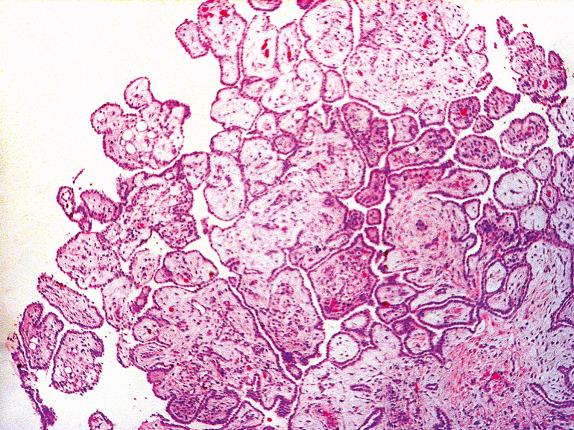

With presentation typically at a late clinical stage, the median survival of malignant mesothelioma from time of diagnosis is 12 months, and the tumor almost invariably causes death within a few years of diagnosis. A survival benefit for a highly selected patient population treated with radical surgery and postoperative combined modality therapy has been shown, but debulking surgery in the forms of pneumonectomy or pleurectomy with adjuvant chemoradiotherapy is typically directed with palliative intent. Well-differentiated papillary mesothelioma, however, usually follows a more indolent course. In patients with well-differentiated papillary mesothelioma, a recent study found an average survival of 74 months compared with 9.89 months for 1248 paired patients with diffuse malignant mesothelioma and a 10-year survival rate of 30.8%.
Mesenchymal tumor derived from submesothelial connective tissues, usually behaving in a benign fashion and occasionally more aggressively
Uncommon
Although most tumors are indolent, a subset is locally invasive
Local recurrence occurs in approximately 10% of cases, particularly in a setting of incomplete resection
Metastasis is uncommon (5%–10%), and death is rare
Typically diagnosed in individuals in the sixth and seventh decades of life but have been reported in all age groups
No gender predilection
No association with exposure to asbestos
Often clinically occult and detected incidentally
Larger tumors may cause symptoms of dyspnea and cough
Rare association with hypoglycemia, a finding reported more frequently in women
May be associated with digital clubbing, pulmonary hypertrophic osteoarthropathy
Sharply circumscribed and of uniform density
Increased attenuation after contrast administration reflects vascularity
Rarely calcified
May cause pleural effusion
Resectability is the major predictor of clinical behavior, and complete resection is usually associated with an excellent prognosis
Invasive and incompletely resected tumors can recur and have the potential for intrathoracic spread and distant metastasis
Malignant histologic features have been recognized in a subset of neoplasms, and negative associations with recurrence-free and metastasis-free survival have been reported
No role for chemotherapy or radiation therapy
Typically 5 to 6 cm, may be extremely large and occupy entire pleural cavity
Often attached to the pleural surface by a vascular pedicle
Usually smooth and encapsulated
Whorled gray-white tumor surface on cut section
Can also arise within the parenchyma of the lung
Usually bland fibroblastic proliferation, typically features zonation with cellular areas and collagenization, sometimes wiry “keloidal” collagen
Fascicular, storiform, hemangiopericytic, and “patternless” growth patterns
Histologic features associated with malignancy include mitotic activity in excess of four per 2 mm 2 , increased pleomorphism, and necrosis
Positive vimentin, CD34, and BCL-2 immunoreactivity
Negative cytokeratin, epithelial membrane antigen, calretinin, S-100, desmin, and actin immunoreactivity
STAT6 is a sensitive and specific immunohistochemical stain for this tumor
The NAB2-STAT6 fusion gene is present in most solitary fibrous tumors
Sarcomatoid and desmoplastic mesothelioma
Desmoid tumor
Monophasic synovial sarcoma
Other spindle cell sarcomas
Historically bearing the misleading name benign mesothelioma or benign fibrous mesothelioma, solitary (or localized) fibrous tumor is the most common mesenchymal pleural neoplasm. Unlike mesothelioma, solitary fibrous tumor (SFT) has no association with asbestos exposure and has been shown on the basis of immunohistochemical and ultrastructural studies to be derived from submesothelial mesenchymal elements. These tumors can also arise less frequently in the parenchyma of the lung, as well as numerous other locations throughout the body. Although most of these tumors arising from pleura are benign, up to 10% are malignant.
Typically occurring in middle age, SFT has been described in childhood and in all life stages and with approximately equal gender distribution. Often clinically occult, a large percentage of these tumors are detected incidentally. Common clinical complaints include dyspnea, chest pain, and cough, accompanied by pulmonary osteoarthropathy, digital clubbing, and pleural effusion. The common laboratory finding of hypoglycemia is believed to be related to the tumor’s elaboration of an insulin-like growth factor and has been reported more frequently in women.
SFTs show no predilection for laterality and are typically located in the inferior zones of the chest. Ranging in size from 1 cm to occupying the entirety of the pleural cavity, these sharply circumscribed and lobulated masses are of uniform density, and the obtuse angle formed by the tumor at its intersection with mediastinum or chest wall suggests an extrapulmonary location. Occasionally, these tumors may lie in or adjacent to a fissure or intraparenchymally. Calcification is seen in fewer than 10% of cases. A reported increase in attenuation after contrast reflects the tumor’s vascularity.
Become a Clinical Tree membership for Full access and enjoy Unlimited articles
If you are a member. Log in here